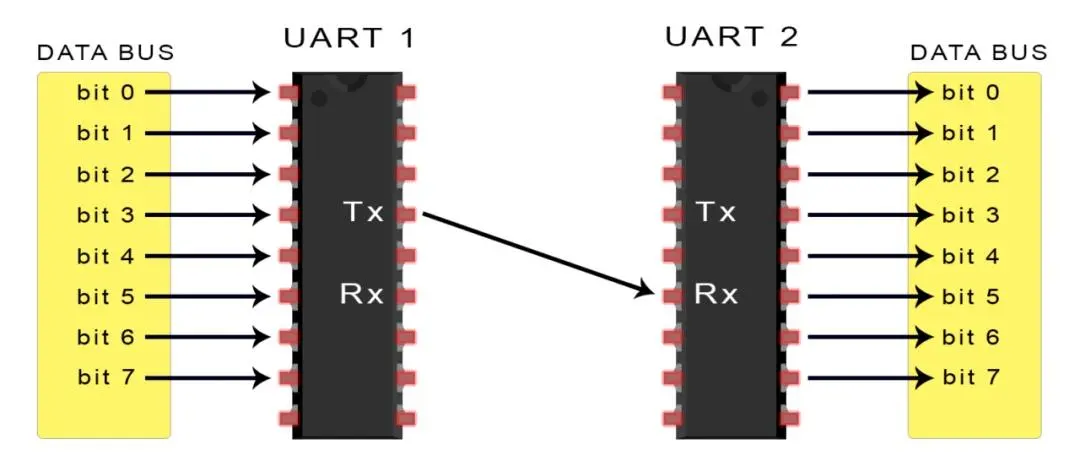
In the realm of microcontroller programming and embedded systems, serial communication is a fundamental aspect. Three of the most common serial communication protocols are UART (Universal Asynchronous Receiver/Transmitter), SPI (Serial Peripheral Interface), and I2C (Inter-Integrated Circuit). This article provides an in-depth explanation of each, exploring their characteristics, operation, and applications.
UART: The Asynchronous Communicator
UART is a serial communication protocol that allows for the transmission of data between devices asynchronously, meaning without a clock signal to synchronize the data rate. It is widely used for communication over distances where a clock signal distributed along with the data would be impractical.
- Operation: UART operates on a start bit, data bits, parity bit (optional), and a stop bit, allowing for flexible data transmission rates and configurations.
- Applications: Commonly used for RS-232 and RS-485 communication in computer peripherals, modems, and microcontroller programming.
SPI: The Synchronous Interface
SPI is a synchronous serial communication interface that operates on a master-slave architecture, facilitating high-speed data transfers between a master device and one or more slave devices.
- Operation: SPI communication requires a minimum of three lines: SCLK (Serial Clock), MOSI (Master Out Slave In), and MISO (Master In Slave Out). It also includes a Slave Select (SS) line for each slave device to enable individual device communication.
- Applications: SPI is ideal for short-distance communication with high data rates, such as in EEPROMs, sensors, and SD cards.
I2C: The Multi-Master Bus
I2C is a multi-master, serial computer bus that allows multiple devices to communicate with a master device over a two-wire interface: SCL (Serial Clock Line) and SDA (Serial Data Line).
- Operation: I2C uses an acknowledgment mechanism to ensure reliable data transfer and supports multiple masters, which can take control of the bus to initiate communication.
- Applications: I2C is used in a variety of applications, including system management in computers, communication between microcontrollers and peripherals, and in automotive and industrial applications.
Comparing UART, SPI, and I2C
While all three protocols enable serial communication, they differ in their architecture, speed, complexity, and use cases:
- Speed: SPI generally offers higher data transfer rates than UART and I2C due to its synchronous nature.
- Complexity: UART requires additional lines for control, while SPI and I2C have simpler wiring requirements.
- Topology: SPI uses a point-to-point connection, UART can be point-to-point or multi-drop, and I2C forms a bus system with multiple devices.
- Master/Slave: SPI is inherently a master-slave protocol, UART does not have this distinction, and I2C supports multi-master capability.
Strategies for Choosing the Right Protocol
When deciding which protocol to use, consider the following:
- Communication Requirements: Assess the data rate, distance, and reliability needed for your application.
- Device Compatibility: Ensure the protocol is supported by all devices in the communication network.
- System Architecture: Consider the existing system architecture and the ease of integration with the new protocol.
Challenges and Considerations
Each protocol presents challenges, such as ensuring data integrity in UART, managing multiple slaves in SPI, and handling bus contention in I2C.
Overcoming Communication Challenges
- UART: Implement robust error-checking and consider using hardware flow control for reliability.
- SPI: Plan the SS line management carefully to prevent conflicts when multiple slaves are present.
- I2C: Use proper arbitration and acknowledge mechanisms to manage multi-master scenarios.
Conclusion
UART, SPI, and I2C are essential protocols for serial communication in embedded systems, each with its unique features and ideal applications. By understanding their differences and choosing the appropriate protocol based on specific project requirements, developers can ensure efficient and reliable data transmission. As technology advances, these protocols will continue to evolve, supporting new applications and enhancing the way devices communicate.



